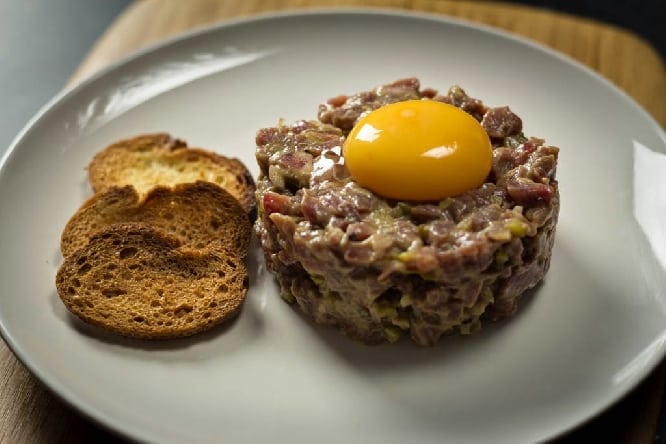Steak tartare is made from minced, ground or finely chopped meat – chiefly beef but also venison and, in some countries, horse meat.
Sometimes it is cut into strips and beaten until flat, then marinated, chilled and served raw, often with an equally raw egg yolk on top.
It’s most likely that the dish gets its name from tartare sauce – made with mayonnaise mixed with finely chopped onions, cucumber and capers – served with steak in French restaurants early in the twentieth century. Originally called steak à l’américaine, the recipe then evolved into the dish as we know it today.
There is, however, a much more entertaining suggestion for its origin: that the dish comes from the Tartars themselves – the nomadic people of the Central Asian steppes.
Renowned horsemen, their name, Tatar or Tartar, derives from the Turkish or Persian Tätär, meaning a mounted courier or messenger, although some etymologists maintain that the ‘r’ was added by the Romans, who associated the savage riders with Tartarus, their name for Hell.
Fiercest among the Tartars was their famed leader, the emperor of all emperors, Genghis Khan (c.1167–1227), who invaded and conquered two-thirds of the known world – stretching from the Pacific to the River Volga – with his army of Mongol horsemen. Constantly on the move, his men had to eat on the hoof – quite literally.
Famous for staying in their saddles for very long periods as they rode towards yet another land in need of conquering, the Mongols discovered that if they carried their meat ration wedged under their saddles, by the end of the day the toughest piece of steak would be tenderized enough to eat.
Sometimes they would chop up and flatten this meat into little patties, which tasted better warm off the horse’s flank than if the rider had stopped to build a camp fire to cook his food.
By the time the emperor’s grandson, Khublai Khan (1215–94), finally conquered Moscow, they had introduced their tenderized meat rations to the locals, who named it steak Tartar, which, for them, meant ‘steak of the violent invaders.’
Over the years, chefs from Russia and further afield developed the dish and diners no longer need to ride over rugged terrain for several days with it wrapped around their horses before eating it.
It’s a great story, but according to some historians there’s no reference to such a practice in medieval records, neither in the Middle or the Far East. His theory is that the story most likely arose from an existing practice by the Central Asian nomads for putting pieces of meat on their horses’ backs.
But the reason they did it was to lubricate and soothe their mounts’ sores, much as we would put a raw steak on a black eye. Which isn’t to say that they wouldn’t have eaten it afterwards. – Albert Jack
Albert Jack AUDIOBOOKS available for download here
More Food History with Albert Jack








































